Computational and Experimental Study of Nonlinear Optical Susceptibilities of Composite Materials Based on PVK Polymer Matrix and Benzonitrile Derivatives
- PMID: 35329529
- PMCID: PMC8949124
- DOI: 10.3390/ma15062073
Computational and Experimental Study of Nonlinear Optical Susceptibilities of Composite Materials Based on PVK Polymer Matrix and Benzonitrile Derivatives
Abstract
Theoretical and experimental investigations of the linear and nonlinear optical properties of composite materials based on the (Z)-4-(1-cyano-2-(5-methylfuran-2-yl)vinyl)benzonitrile molecule named as A, the (Z)-4-(2-(benzofuran-2-yl)-1-cyanovinyl)benzonitrile named as B and the (Z)-4-(2-(4-(9H-carbazol-9-yl)phenyl)-1-cyanovinyl)benzonitrile molecule named as C embedded into poly(1-vinylcarbazole) (PVK) polymer matrix were performed. The electronic and optical properties of A, B, and C molecules in a vacuum and PVK were calculated. The guest-host polymer structures for A, B, and C molecules in PVK were modeled using molecular dynamics simulations. The spatial distribution of chromophores in the polymer matrix was investigated using the intermolecular radial distribution (RDF) function. The reorientation of A, B, and C molecules under the influence of the external electric field was investigated by measuring the time-dependent arrangement of the angle between the dipole moment of the chromophore and the external electric field. The polarizabilities and hyperpolarizabilities of tested compounds have been calculated applying the DFT/B3LYP functional. The second- and third-order nonlinear optical properties of the molecule/PVK thin film guest-host systems were investigated by the Maker fringes technique in the picosecond regime at the fundamental wavelength of 1064 nm. The experimental results were confirmed and explained with theoretical simulations and were found to be in good agreement. The modeling of the composites in volumetric and thin-film form explains the poling phenomena caused by the external electric field occurring with the confinement effect.
Keywords: PVK; density functional thery (DFT); guest–host composite; hyperpolarizability; molecular dynamics; nonlinear optics; nonlinear optics (NLO).
Conflict of interest statement
The authors declare no conflict of interest.
Figures


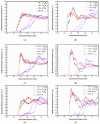
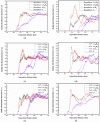
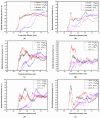






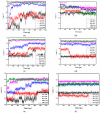



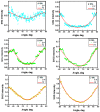

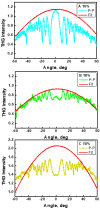
Similar articles
-
Hierarchical Modeling of the Nonlinear Optical Response of Composite Materials Based on Tetrathiafulvalene Derivatives.Molecules. 2024 Aug 6;29(16):3720. doi: 10.3390/molecules29163720. Molecules. 2024. PMID: 39202800 Free PMC article.
-
Second order nonlinear optical properties of poled films containing azobenzenes tailored with azulen-1-yl-pyridine.Heliyon. 2023 Jun 17;9(6):e17360. doi: 10.1016/j.heliyon.2023.e17360. eCollection 2023 Jun. Heliyon. 2023. PMID: 37441403 Free PMC article.
-
Molecular structure, second- and third-order nonlinear optical properties and DFT studies of a novel non-centrosymmetric chalcone derivative: (2E)-3-(4-fluorophenyl)-1-(4-{[(1E)-(4-fluorophenyl)methylene]amino}phenyl)prop-2-en-1-one.Spectrochim Acta A Mol Biomol Spectrosc. 2017 Sep 5;184:342-354. doi: 10.1016/j.saa.2017.05.015. Epub 2017 May 9. Spectrochim Acta A Mol Biomol Spectrosc. 2017. PMID: 28528255
-
Modeling of Nonlinear Optical Phenomena in Host-Guest Systems Using Bond Fluctuation Monte Carlo Model: A Review.Materials (Basel). 2021 Mar 16;14(6):1454. doi: 10.3390/ma14061454. Materials (Basel). 2021. PMID: 33809785 Free PMC article. Review.
-
Carbon nanotube-based functional materials for optical limiting.J Nanosci Nanotechnol. 2007 Apr-May;7(4-5):1268-83. doi: 10.1166/jnn.2007.308. J Nanosci Nanotechnol. 2007. PMID: 17450890 Review.
Cited by
-
Hierarchical Modeling of the Nonlinear Optical Response of Composite Materials Based on Tetrathiafulvalene Derivatives.Molecules. 2024 Aug 6;29(16):3720. doi: 10.3390/molecules29163720. Molecules. 2024. PMID: 39202800 Free PMC article.
-
Topography and Nonlinear Optical Properties of Thin Films Containing Iodide-Based Hybrid Perovskites.Nanomaterials (Basel). 2023 Dec 23;14(1):50. doi: 10.3390/nano14010050. Nanomaterials (Basel). 2023. PMID: 38202504 Free PMC article.
References
-
- Dalton L., Harper A., Ren A., Wang F., Todorova G., Chen J., Zhang C., Lee M. Polymeric Electro-optic Modulators: From Chromophore Design to Integration with Semiconductor Very Large Scale Integration Electronics and Silica Fiber Optics. Ind. Eng. Chem. Res. 1999;38:8–33. doi: 10.1021/ie9705970. - DOI
-
- Alyar H. A Review on nonlinear optical properties of donor-acceptor derivatives of naphthalene and azanaphthalene. Rev. Adv. Mater. Sci. 2013;34:79–87.
-
- Verbiest T., Houbrechts S., Kauranen M., Clays K., Persoons A. Second-order nonlinear optical materials: Recent advances in chromophore design. J. Mater. Chem. 1997;7:2175–2189. doi: 10.1039/a703434b. - DOI
Grants and funding
LinkOut - more resources
Full Text Sources

